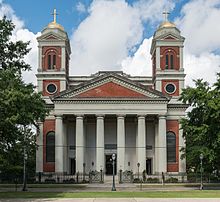Immaculate Conception Cathedral Basilica (Mobile)
The Cathedral Basilica of the Immaculate Conception ( English Cathedral Basilica of the Immaculate Conception ) is a Roman Catholic Church in Mobile in the US state of Alabama . The cathedral of the Archdiocese of Mobile is dedicated to the Blessed Virgin Mary under the patronage of the Immaculate Conception and has the title of a minor basilica . It is listed as part of two historic neighborhoods on the National Register of Historic Places .
history
In what was then a French colony, the parish of Mobile was founded on July 20, 1703 by Jean-Baptiste de la Croix Chevrière de Saint-Vallier , Bishop of Quebec , in the citadel of Fort Louis de la Louisiane as the first on the Gulf Coast.
After moving the settlement of Mobile to its current location in 1711, the community was given the name Immaculata Conception in Spanish times in 1781. In 1781, during the Spanish time of Mobile, the community received its current name as Inmaculada Concepcíon.
Mobile became the first bishop to become a diocese in 1829 with the French Michael Portier. The first cathedral to be used was a small wooden church at the cemetery, where today's cathedral is located, and planning soon began. The cathedral was designed by Claude Beroujon in 1833 as a classical basilica in the style of the Greek Revival . Construction began in 1835, but the economic crisis of 1837 delayed progress. The cathedral was consecrated in 1850 by the bishop porter. After severe damage from the explosion of a nearby ammunition depot in 1865, the portico could only be completed in the 1870s and the towers only in 1884. The large stained glass windows from the Mayer'schen Hofkunstanstalt were installed between 1890 and 1910. In 1954, a fire caused severe damage, which required considerable restoration work, including on the stained glass windows.
In 1962 Pope John XXIII raised the cathedral to the Basilica minor. The last renovation took place in the 2000s when the corridors were given a marble floor with the coats of arms of the bishops and archbishops of Mobile.
architecture
The classical portico, which is oriented roughly to the east, is characterized by eight massive columns in the Roman-Doric style. The 31 meter high church towers of the double tower facade rise to the side . Behind it, the three-aisled building extends 50 meters to the west and is 27 meters wide. The barrel vault rises up to 18 meters.
Furnishing
The stained glass windows made in Munich form the most striking part of the furnishings. The twelve main windows on the sides are approximately 2.4 meters wide and 7.0 meters high. They show various Marian events that Mary includes in the life of her son Jesus. There are also other pictures next to the portico and in the foyer.
After the fire, a new mahogany pulpit was installed. A massive bronze ciborium was added above the altar , supported by four marble columns. The organ from 1858 was replaced by a new instrument from the Wicks Organ Company with 3,000 pipes in 47 registers .
Web links
- Web site of the Cathedral (English)
Individual evidence
- ↑ Entry in the National Register Information System . National Park Service , accessed October 29, 2019
- ↑ Jay Higginbotham: Old Mobile: Fort Louis de la Louisiane, 1702-1711 . (Museum of the City of Mobile, 1977) pp. 106-107.
- ↑ Cathedral Basilica of the Immaculate Conception on gcatholic.org (English)
- ^ Sharon V. Buck: The Stained Glass Windows of Mobile's Cathedral Basilica of the Immaculate Conception . In: The Stained Glass Quarterly , Stained Glass Association of America, Fall 1997.
- ^ The Organ at the Cathedral Basilica of the Immaculate Conception. Retrieved October 29, 2019 .
Coordinates: 30 ° 41 '24 " N , 88 ° 2' 44.9" W.


